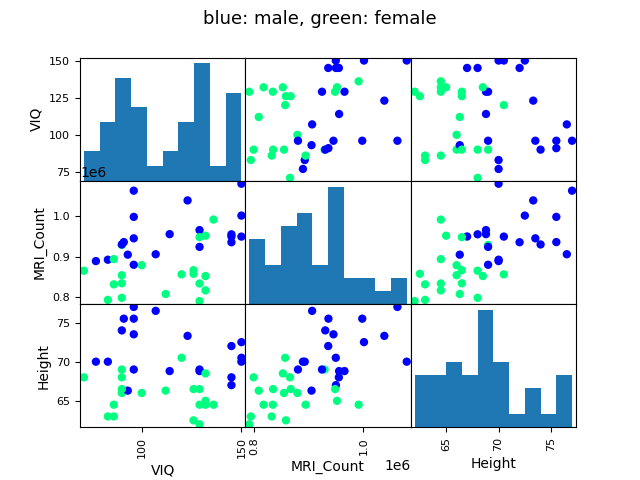注意
转到末尾 下载完整的示例代码。
性别与智商的关系¶
回到脑容量 + 智商数据,在去除脑容量、身高和体重的影响后,测试男性和女性的言语智商 (VIQ) 是否存在差异。
注意,这里“性别”是一个类别值。由于它是非浮点型数据,statsmodels 可以自动推断这一点。
import pandas
from statsmodels.formula.api import ols
data = pandas.read_csv("../brain_size.csv", sep=";", na_values=".")
model = ols("VIQ ~ Gender + MRI_Count + Height", data).fit()
print(model.summary())
# Here, we don't need to define a contrast, as we are testing a single
# coefficient of our model, and not a combination of coefficients.
# However, defining a contrast, which would then be a 'unit contrast',
# will give us the same results
print(model.f_test([0, 1, 0, 0]))
OLS Regression Results
==============================================================================
Dep. Variable: VIQ R-squared: 0.246
Model: OLS Adj. R-squared: 0.181
Method: Least Squares F-statistic: 3.809
Date: Mon, 07 Oct 2024 Prob (F-statistic): 0.0184
Time: 04:57:10 Log-Likelihood: -172.34
No. Observations: 39 AIC: 352.7
Df Residuals: 35 BIC: 359.3
Df Model: 3
Covariance Type: nonrobust
==================================================================================
coef std err t P>|t| [0.025 0.975]
----------------------------------------------------------------------------------
Intercept 166.6258 88.824 1.876 0.069 -13.696 346.948
Gender[T.Male] 8.8524 10.710 0.827 0.414 -12.890 30.595
MRI_Count 0.0002 6.46e-05 2.615 0.013 3.78e-05 0.000
Height -3.0837 1.276 -2.417 0.021 -5.674 -0.494
==============================================================================
Omnibus: 7.373 Durbin-Watson: 2.109
Prob(Omnibus): 0.025 Jarque-Bera (JB): 2.252
Skew: 0.005 Prob(JB): 0.324
Kurtosis: 1.823 Cond. No. 2.40e+07
==============================================================================
Notes:
[1] Standard Errors assume that the covariance matrix of the errors is correctly specified.
[2] The condition number is large, 2.4e+07. This might indicate that there are
strong multicollinearity or other numerical problems.
<F test: F=0.683196084584229, p=0.4140878441244694, df_denom=35, df_num=1>
这里我们绘制散点矩阵以获得对结果的直观认识。这超出了练习中要求的内容。
# This plotting is useful to get an intuitions on the relationships between
# our different variables
from pandas import plotting
import matplotlib.pyplot as plt
# Fill in the missing values for Height for plotting
data["Height"] = data["Height"].ffill()
# The parameter 'c' is passed to plt.scatter and will control the color
# The same holds for parameters 'marker', 'alpha' and 'cmap', that
# control respectively the type of marker used, their transparency and
# the colormap
plotting.scatter_matrix(
data[["VIQ", "MRI_Count", "Height"]],
c=(data["Gender"] == "Female"),
marker="o",
alpha=1,
cmap="winter",
)
fig = plt.gcf()
fig.suptitle("blue: male, green: female", size=13)
plt.show()

脚本总运行时间:(0 分 0.235 秒)